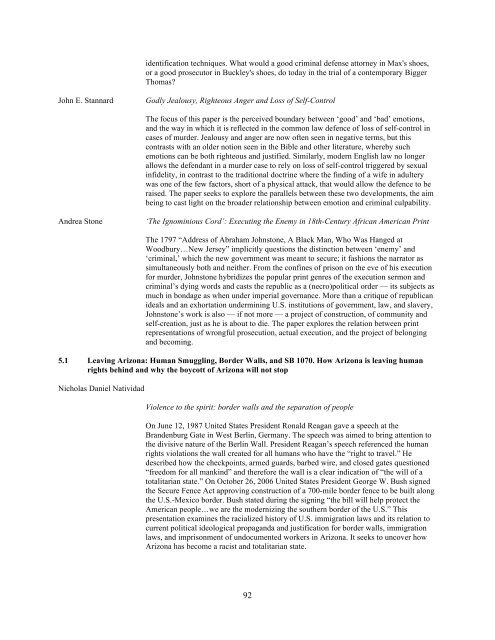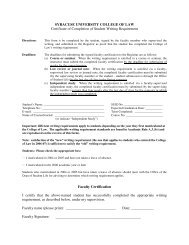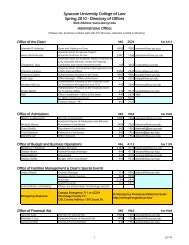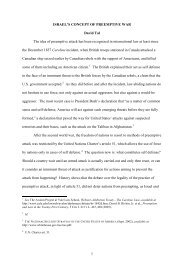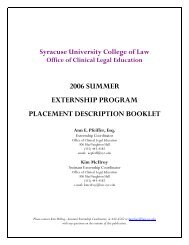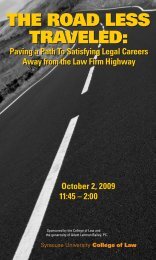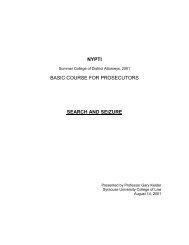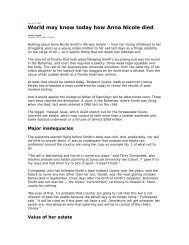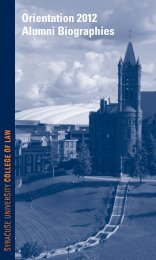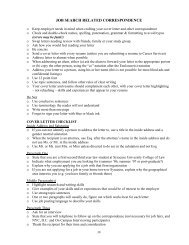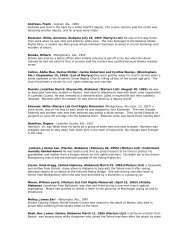2011 Conference Program (PDF) - Syracuse University College of Law
2011 Conference Program (PDF) - Syracuse University College of Law
2011 Conference Program (PDF) - Syracuse University College of Law
Create successful ePaper yourself
Turn your PDF publications into a flip-book with our unique Google optimized e-Paper software.
identification techniques. What would a good criminal defense attorney in Max's shoes,<br />
or a good prosecutor in Buckley's shoes, do today in the trial <strong>of</strong> a contemporary Bigger<br />
Thomas<br />
John E. Stannard<br />
Godly Jealousy, Righteous Anger and Loss <strong>of</strong> Self-Control<br />
The focus <strong>of</strong> this paper is the perceived boundary between ‘good’ and ‘bad’ emotions,<br />
and the way in which it is reflected in the common law defence <strong>of</strong> loss <strong>of</strong> self-control in<br />
cases <strong>of</strong> murder. Jealousy and anger are now <strong>of</strong>ten seen in negative terms, but this<br />
contrasts with an older notion seen in the Bible and other literature, whereby such<br />
emotions can be both righteous and justified. Similarly, modern English law no longer<br />
allows the defendant in a murder case to rely on loss <strong>of</strong> self-control triggered by sexual<br />
infidelity, in contrast to the traditional doctrine where the finding <strong>of</strong> a wife in adultery<br />
was one <strong>of</strong> the few factors, short <strong>of</strong> a physical attack, that would allow the defence to be<br />
raised. The paper seeks to explore the parallels between these two developments, the aim<br />
being to cast light on the broader relationship between emotion and criminal culpability.<br />
Andrea Stone<br />
‘The Ignominious Cord’: Executing the Enemy in 18th-Century African American Print<br />
The 1797 “Address <strong>of</strong> Abraham Johnstone, A Black Man, Who Was Hanged at<br />
Woodbury…New Jersey” implicitly questions the distinction between ‘enemy’ and<br />
‘criminal,’ which the new government was meant to secure; it fashions the narrator as<br />
simultaneously both and neither. From the confines <strong>of</strong> prison on the eve <strong>of</strong> his execution<br />
for murder, Johnstone hybridizes the popular print genres <strong>of</strong> the execution sermon and<br />
criminal’s dying words and casts the republic as a (necro)political order — its subjects as<br />
much in bondage as when under imperial governance. More than a critique <strong>of</strong> republican<br />
ideals and an exhortation undermining U.S. institutions <strong>of</strong> government, law, and slavery,<br />
Johnstone’s work is also — if not more — a project <strong>of</strong> construction, <strong>of</strong> community and<br />
self-creation, just as he is about to die. The paper explores the relation between print<br />
representations <strong>of</strong> wrongful prosecution, actual execution, and the project <strong>of</strong> belonging<br />
and becoming.<br />
5.1 Leaving Arizona: Human Smuggling, Border Walls, and SB 1070. How Arizona is leaving human<br />
rights behind and why the boycott <strong>of</strong> Arizona will not stop<br />
Nicholas Daniel Natividad<br />
Violence to the spirit: border walls and the separation <strong>of</strong> people<br />
On June 12, 1987 United States President Ronald Reagan gave a speech at the<br />
Brandenburg Gate in West Berlin, Germany. The speech was aimed to bring attention to<br />
the divisive nature <strong>of</strong> the Berlin Wall. President Reagan’s speech referenced the human<br />
rights violations the wall created for all humans who have the “right to travel.” He<br />
described how the checkpoints, armed guards, barbed wire, and closed gates questioned<br />
“freedom for all mankind” and therefore the wall is a clear indication <strong>of</strong> “the will <strong>of</strong> a<br />
totalitarian state.” On October 26, 2006 United States President George W. Bush signed<br />
the Secure Fence Act approving construction <strong>of</strong> a 700-mile border fence to be built along<br />
the U.S.-Mexico border. Bush stated during the signing “the bill will help protect the<br />
American people…we are the modernizing the southern border <strong>of</strong> the U.S.” This<br />
presentation examines the racialized history <strong>of</strong> U.S. immigration laws and its relation to<br />
current political ideological propaganda and justification for border walls, immigration<br />
laws, and imprisonment <strong>of</strong> undocumented workers in Arizona. It seeks to uncover how<br />
Arizona has become a racist and totalitarian state.<br />
!<br />
92


